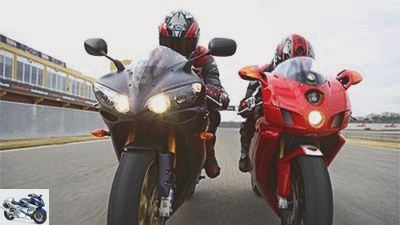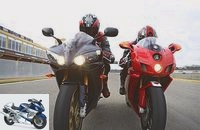Menus

Bilski
Race track comparison Ducati 999 R, Yamaha YZF-R1 SP
Noble & Strong
The race bike is noble, sporty and good. Ideally equipped with everything you need to be able to turn directly from the dealer onto the racetrack. Ducati has its superbike base 999 R ready for this. Yamaha is now following up with the noble YZF-R1 SP. Which concept stands out on the racetrack ?
SP – like Sport Production. Two letters that caused an uproar in the full throttle group at the end of the eighties-
ten. Ducati used this abbreviation to ennoble the street-market offshoots of the superbikes. First the 851, later the 888. Exclusive small series with everything that is necessary, good and expensive for driving fast. Almost unaffordable and the dream of many race-infected sports drivers.
Over time, the SP gave way to an R, which is also the youngest representative of this
Line, the 999 R, adorns. Your Testastretta is the most powerful 1000 series twin of all time. 104 millimeter bore, injection system with nozzles enthroned centrally above the intake funnels and magnesium valve covers set it apart from the other 999, as do the light forged wheels or the carbon cladding.
Yamaha also had this art-
times cared for. 1989, with the OW 01 or
real name FZR 750 R. Der
followed by the YZF 750 SP and later
the YZF-R7. Then the idea slumbered again. Now the time for such an image carrier was apparently ripe again and the YZF-R 1 has put the »SP« aside. However, the Japanese do not have the radical approach like the Italians, but only spice up their top athletes in the areas of chassis and wheels. Except for the slipper clutch, the engine is identical to that of the civil sister. Why change what is good? After all, Yamaha attests to the thousand 175 hp. The direct comparison with the tight 150 hp Ducati seems a little unfair at first. But have the four-cylinder power bolts actually left the two-cylinder concept behind?
It is a professional’s job to explore this. Peter Ottl, ex-GP driver, should 999 R and R1 SP, soled with Bridgestone BT 002, on the angled course from Valencia to the tooth. For the fence guests at the pit wall, it is already decided by the paper form alone: more handy, stronger – the R1 makes short work.
And when Peter swept down the home straight a short time later with a triumphant howling Yamaha, the matter seems to be clear anyway. Strongest two-cylinder or not, the Duc shouldn’t have anything to oppose this hurricane. On this more than cool day on the R1 SP, Peter clearly feels right at home, nibbles one tenth after the other lap after lap and drives the Yamaha around the course in 1.46.2 minutes on the last lap of his turn. That would even qualify him for the Superstock EM.
Power is not an issue with the Yamaha, always and everywhere in abundance. Much more important, however: “The power is to be metered excellently at the exit of the bend, there you can implement the enormous pressure of the four-cylinder in a hair-perfect manner,” said Peter, enthusiastic about this hurricane and his crazy revving.
And the winding passages of the Spanish route are just right for the R1. Even the ordinary R1 turns a long nose for the rest of the 1000 pack when it comes to handling. Due to the Marchesini forged wheels, which weigh around 400 grams compared to the standard wheels
Saving weight makes the SP even more light-footed. It’s wonderful how playfully she turns in, how willing she is to give steering commands
obeyed and how effortlessly she got through
Harassment swirls. “You have to get used to it so that you don’t
turns too quickly and always too early
arrives at the apex «, grins Peter,» and stability and feedback in fast passages are really good. «
No wonder, because the Ohlins spring elements are of the high quality. In the fork there are milled instead of cast damper pistons as well as preload sleeves and damper rods made of aluminum instead of steel. The shock absorber shows off high and low-speed adjusters for the compression stage as well as hydraulic spring adjustment. The Eldorado for voting tinkerers. The Sweden dampers are sensitive to set-up changes and work almost perfectly. “The shock absorber ensures great grip on the rear wheel and an impeccable feeling for the limit,” explains Peter Ottl.
Accelerating brilliantly is one thing, but there is more to a fast lap. Braking like the devil, for example. No problem with the SP either. “Great pressure point, nice and constant and pleasantly hard,” says Peter. The whole thing is combined with an anti-hopping clutch, which keeps the rear of the SP under control when braking, as inconspicuously as it is effective, and a sensitive, firm fork. Where should the Duc score??
Meanwhile, Peter tugs the station wagon, checks the data recording again and then roars out onto the slopes with the 999 R on the rear wheel. Show time.
It takes Peter two laps to switch from the speed animal R1 to the massive two-cylinder, then times start to tumble. After all, he wants to know in the last round. Thunders, folded up behind the panel like a towel, along the pit wall. Despite the somewhat disappointingly blunt Brembo stoppers, throttle valves on stop, the 999 hammers loudly towards the braking point, and beyond. A blink of an eye later, Peter straightens up in a flash, slows down as much as he can. The Ducati lurches gently, the rear tire whimpers, and the 999 R plunges into the fast left-hand bend with a hair-raising lean. Everyone looks at the stopwatch: 1.45.4 minutes.
A little later, the ex-GP driver rolls out in the pit lane. “Fantastic, how precise, how stable,” it gushes out from under the helmet. But where does the Ducati get the time? Although it has clear plus points in handling compared to the other 999 models due to the lighter forged wheels, it does not come close to the agility of the R1 SP. If you want to get through alternating curves quickly, the driver has to work a lot with his body. “If you take this small disadvantage into account when choosing the line, you can live with it,” says the professional. In general, the choice of line: The precision with which the 999 R accurately traces its path on the targeted line is awesome. Especially at the exit of a curve. The Ducati stays on course more precisely than the Yamaha, which describes slightly wider curves.
Which is why you can let the Testastretta-Twin off the leash much earlier and more violently than the one with its powerful acceleration at medium speeds
medium speeds somewhat more restrained tackling four-cylinder. In this way, the Ducati makes good meters at every corner exit. “In addition,” remembers Peter, “the gear ratio, especially the important second gear, fits perfectly here.” So the R1 cannot convert its extra power into a speed advantage on the back straight.
Even more. The chassis of the Ducati with the creamy, firm Ohlins spring elements is superbly balanced.
All of this merges into one ultra-stable
Unit that provides the pilot with the finest feedback and instills him with the confidence for enormous cornering speeds.
This becomes particularly clear in the curve at the end of the home straight. If the Yamaha is there at the top of the curve 110 km / h, the Ducati rushes through with 120 km / h. And in the fast left curve leading over a knoll before the start / finish, its great transparency enables you to accelerate with unbelievable vehemence along the slide limit towards the braking point. But the longer a straight, the more imposing the Yamaha is
in scene and seems with her sheer
Power to tear everything down.
Nevertheless, the Ducati has the finish line by 0.8 seconds or 58 meters
Fairing nose in front. Perhaps the result would have looked different on a faster track like Mugello or Barcelona, but the comparison shows that performance is not everything and the Ducati with theirs
V2 still full of music.
Buy complete article

Race track comparison Ducati 999 R, Yamaha YZF-R1 SP
Noble & Strong
Circuit: Valencia / E Length: 4.005 km
When entering the home straight, the Ducati initially wins almost three tenths. However, the Yamaha converts its extra power up to the braking point at the end of the home straight (1) into 259 km / h top speed (Ducati 252 km / h). Which gives you an advantage of two tenths at the next corner.
The R1’s gear and speed match up to the next bend, which is why it gains another one and a half tenths. In the subsequent curvy section up to the entrance of the back straight (3) you look
the Ducati but eight tenths off. It also takes much more momentum there, which is why both are practically the same speed at the braking point (4). The following 180-degree left-hand bend (5), which is generally hanging outwards, is six km / h faster through the 999 R. The approach
In an inclined position on the tricky, tight right-hand bend, the Ducati succeeds thanks to the crystal-clear feedback with more pull, more speed and two and a half tenths faster. The Ducati also accelerates much more vehemently over the following long left-hand curve (6), which brings another one and a half tenths.
Related articles
-
Ducati Panigale R and Yamaha YZF-R1M in the track test
24 pictures www. 1/24 Two completely different engine concepts are put to the comparison test. www. 2/24 The tank …
-
Superbike comparison test: Ducati 996 SPS against Yamaha YZF-R7
Superbike comparison test: Ducati 996 SPS against Yamaha YZF-R7 Numerus Sausus These machines are not toys for everyone. Who one of the rare Ducati …
-
Comparison test, Aprilia RS 250, Ducati 916, Honda Fireblade, Kawasaki Ninja ZX-6R, Suzuki GSX-R 750, Yamaha YZF 1000 R Aprilia RS 250, Kawasaki ZX-6 R, …
-
Race track comparison: Ducati Superbike versus STW Audi
Race track comparison: Ducati-Superbike versus STW-Audi rabbit and hedgehog They could hardly be more different, Andy Meklaus Superbike-Ducati and the Audi …
-
Comparison test: Ducati Diavel, Suzuki B-King and Yamaha Vmax
Jahn comparison test: Power Bikes 2011 Ducati Diavel, Suzuki B-King and Yamaha Vmax Content from Big appearance, powerful sound waves, pressure from all …
-
Comparison test between Kawasaki ZX-9R and Yamaha YZF-R1
Comparison test between Kawasaki ZX-9R and Yamaha YZF-R1 motorcycle hike green against red, ZX-9R against YZF-R1. Motorcycles as they are in the book. High quality …
-
Ducati Monster 821 and Yamaha MT-09 in comparison
Bilski 31 pictures Bilski 1/31 Ducati Monster 821 and Yamaha MT-09. Bilski 2/31 … but would fine-tune the chassis and pulling power …
-
Ducati Monster 1200, KTM 690 Duke R and Yamaha MT-09 in comparison
www.bilski-fotografie.de 42 pictures bilski-fotografie.de 1/42 Ducati Monster 1200, KTM 690 Duke R and Yamaha MT-09 in the comparison test bilski-fotografie.de …
-
Ducati Hypermotard 939, Yamaha MT-09 and Aprilia Dorsoduro 900 in comparison test
Arturo Rivas Ducati Hypermotard 939, Yamaha MT-09 and Aprilia Dorsoduro 900 Funbikes in comparison test Now seriously: Have fun and reason …
-
Comparison test Ducati Monster 900 i.e, Moto Guzzi V11 Sport Scura, Yamaha BT 1100 Bulldog
Gargolov comparison test Ducati Monster 900 i.e, Moto Guzzi V11 Sport Scura, Yamaha BT 1100 Bulldog Tingling in the stomach Three very different twins with …